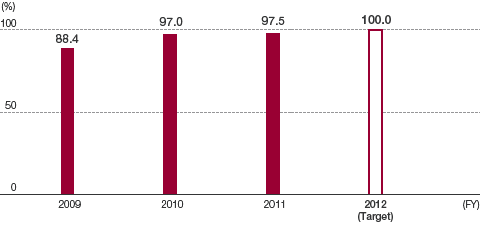 網站內容顯示
網站內容顯示

Basic stance
Contributing to the sustainable development of society and conducting environmentally-friendly business operations are essential issues that need to be addressed in modern business management. The Advantest Group works to develop products from the perspective of environmental conservation while prioritizing high precision and high quality, and certifies products that are environmentally-friendly in terms of the three key aspects of energy saving and resource conservation, improving recyclability, and elimination of hazardous substances as green products.
There is demand in society for the supply of green products because they provide both a reduction in the environmental footprint as well as an improvement in economic value. The Group is developing green products in response to these demands and based on the belief that these products will be beneficial for its customers.
Development flow of green products
At the Advantest Group, all new products undergo a product environmental assessment.
During the environmental assessment, products are assessed from various aspects, including energy savings, the number of parts used, product size, recyclable design, and elimination of hazardous substances. Products that meet the Voluntary Standards for Green Products are certified as green products and are awarded with an Eco Label (type II).
Development flow of green products
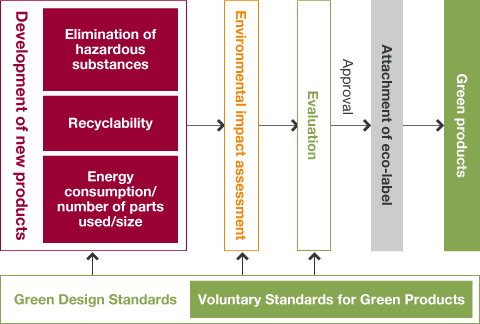
Advantest's Eco Labels
An original three-color design is used for the Group's Eco Label, representing energy saving and resource conservation, recyclable design, and elimination of hazardous substances (green procurement).
Energy Saving and Resource Conservation
Voluntary Standards
- Power-saving design
- Reduced-material design
- Miniaturized design
Recyclable Design
Voluntary Standards
- Design with renewable resin materials
- Design for ease of disassembly
- Disclosure of information on disposal
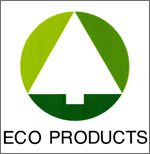
Elimination of Hazardous Substances
(Green Procurement)
Voluntary Standards
- Improvement on green procurement rate
- Elimination of banned substances
Energy saving and resource conservation
To reduce the environmental footprint, the Group takes energy efficiency, the number of parts used, and product size into consideration when conducting product design.
Recyclable design
In recyclable design initiatives, we provide information on parts that require care during disposal, and we promote use of recyclable materials for resin parts that are designed in-house. For products that require disassembling, we ensure disassembly can be easily conducted with general tools, and we only use batteries with a recycle mark.
Elimination of hazardous substances (green procurement)
To eliminate hazardous substances from products, we have established Group standards on banned substances based on the JIG-101 standard (IEC 62474 International Standard to be adopted within fiscal 2012). Based on these standards we conduct studies on the hazardous substances contained within the parts and materials used in our products.
Green products certified during fiscal 2011
The following products were certified as green products and supplied to customers during fiscal 2011.
- T2000 SP2MF
- T5773
- T5773ES
- M4742A
- U38 series
- Five types of T2000 module products
Introducing our Green Products
T5773 Memory Test System
Responding to demands for systems that reduce total test costs
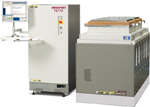
T5773
With the spread of technologies such as smartphones and solid state-drives (SSDs), the production of the NAND-based flash memory that is used within these types of technologies has increased. NAND-based flash memory volumes are also growing, and as a result the time required for device testing is increasing. As device speeds are also becoming faster and faster, the demand for systems that can reduce total test costs has increased. The T5773 was released in July 2012 in response to these needs. The T5773 Memory Test System makes high-efficiency, low-cost measurement possible for a wide range of NAND-based flash memory types, from traditional to high-speed interface.
Weight of parts reduced by 56% and size reduced by 75% compared with comparable products
From the initial development of the T5773, the requirements for the component parts were clarified and optimization was conducted by efficiently using general-purpose parts for sections composed of standard shared units and custom parts. Through this process, reliability was improved, while the weight of parts was reduced by 56% and the size significantly reduced by 75% compared with comparable products.
Possible to include only the required number of test heads
By using a stackable configuration for test heads, it is possible to configure a single test unit that can measure 128 units at the same time, and by selecting between one to six test units, measure up to a maximum of 768 units simultaneously, enabling the user to freely adjust the configuration depending on their requirements. In the past, only the test head size for the maximum-sized configuration was provided. However, the T5773 allows us to provide the size that is optimal for the customer.
Power source location changed and newly developed test processor adopted to reduce the amount of energy consumption by 79%
The power source was installed in the mainframe for previous products, based on the maximum-sized configuration for test heads. However, with the T5773, the power source for the board has been installed within the test unit. For this reason, the mainframe does not require a surplus power source and the distance between the board and power source has been minimized, reducing the amount of power lost through cables and thereby contributing to a reduction in power consumption.
In addition, a test processor has been newly developed for the function board that is central to the test system, which achieves high throughput as well as a 79% reduction in power consumption per unit compared to comparable products.
In this manner, the Group will continue to advance with manufacturing from the customers' perspective.
Aiming to develop products that minimize increases in power consumption

Yuki Taniguchi
7th R&D Department
Memory Test Business Group
Advantest Corporation
In the T5773 development project, we aimed to develop a test module that minimized the increase in power consumption by limiting measurement to NAND-based flash memories. Standard test modules are composed of driver and comparator circuits that use dedicated ICs that are specialized for testers. While these dedicated ICs excel in terms of performance and functionality, they tend to significantly increase the amount of energy consumed. By adopting a driver and comparator circuit that uses general-purpose complementary metal oxide semiconductor (CMOS) ICs for the T5773, it limits the performance and functionality compared to standard testers, but by limiting the T5773 to NAND-based flash memory testing, we were able to successfully develop a test module with low power consumption. We will continue to develop products that minimize power consumption increases by carefully narrowing down the functionality required depending on the subject of measurement.
Comparing products’ environmental information
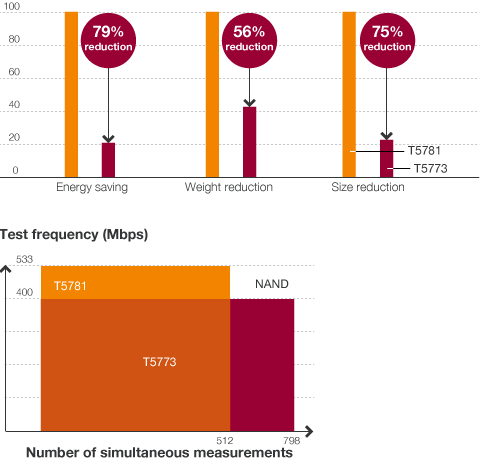
Scalable class testers: the V93000 Smart Scale series
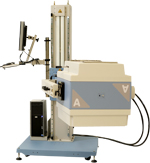
V93000 Smart Scale A-Class
The V93000 Smart Scale series are scalable testers used for evaluating and testing system-on-chip (SOC) devices. Fully compatible with the V93000 platform, the Smart Scale series is an innovative generation of "smart" testers with advanced per-pin capabilities.
Each of the four Smart Scale tester classes - designated A, C, S, and L - has a different test head size, enabling provision of the most efficient solution for each user's specific applications. Because the tester classes are seamlessly compatible with each other, users can quickly and easily move their semiconductor devices from one Smart Scale class to another when the production volume of ICs changes over the lifetime of a device. In addition, flexible system configuration depending on device functionality is made possible through module support.
These functions mean that it is not necessary to introduce a test system for each device to be measured, which makes a significant contribution to efficient use of resources by reducing test costs, conserving test resources, and reducing waste. In addition, increasing test processing capabilities through parallel testing allows users to reduce power consumption per unit.
Promoting Sales of Green Products
Recently, many companies have started working towards business management that is environmentally-responsible. The Advantest Group has adopted an environmental policy that aims to provide green products and reduce the environmental footprint of customers. Based on these aims, the Group is conducting development in accordance with Green Design Standards based on product environmental assessments and providing products that have been certified in accordance with proprietary green product standards.
Fiscal 2011 results
Since fiscal 2010, the Group has established an annual green product sales ratio target (unit-base). Compared to the fiscal 2011 green product sales ratio target of 95%, we achieved a ratio of 97.5%. As a result, we were granted an Eco-VC (Value Creation) Initiative award by a major Japanese semiconductor manufacturer.
In addition, as steps to improve our corporate image, we have added Eco Labels to the product photographs contained on our website to indicate that the applicable products are green certified products and assist customers in selecting green products, and we have also clearly stated environmental footprint reduction data on product presentation materials.
Although there are plans to sell some non-green certified products (used products) during fiscal 2012, we will take steps to ensure that our green product sales ratio is as close as possible to 100% and continue to promote other new programs as we aim to reduce our environmental footprint, including the reuse of High Fidelity Tester Access Fixtures (HIFIX) and the use of returnable packaging materials.
∗ VC:Value Creation
Green product sales ratio (unit-base)
